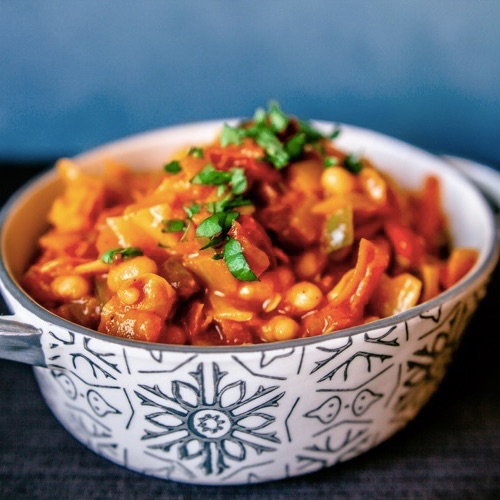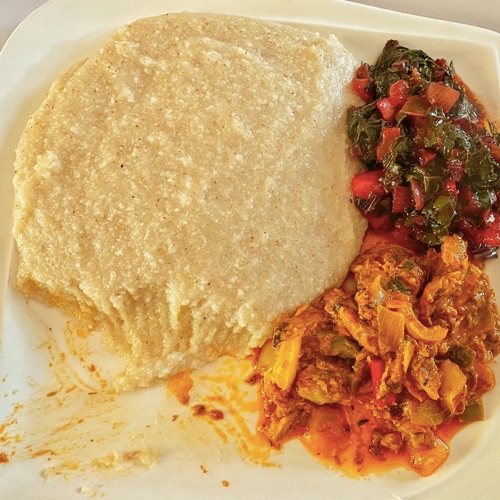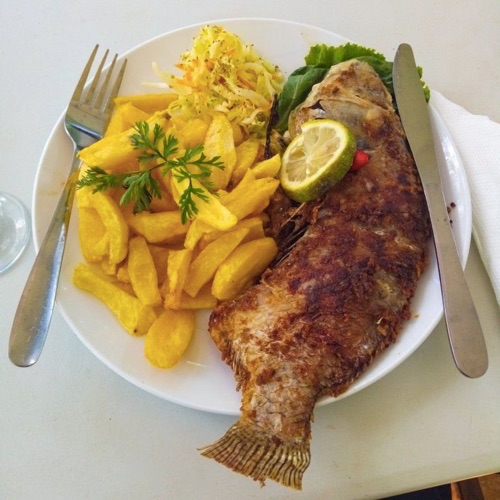Zulu traditional food in South Africa consists of various dishes that are often cooked together communally. Most traditional Zulu foods come from crops, as well as wild leafy vegetables.
Many Zulu dishes such as porridge, maize meal, and beans are vegetarian. However, meat is also a significant part of their cuisine. In fact, they are often known for roasting whole meats on a spit or adding them to stews with vegetables.
Keep your culture close to you by cooking traditional Zulu food. Here are 10 recipes for delicious and authentic meals.

The Most Popular Zulu Traditional Food
- Samp and beans
- Ujeqe
- Amasi
- Imifino
- Phutu
- Chakalaka
- Beef
- Amadumbe
- Isijingi
- Izinkobe zikabhontshisi
Traditional Zulu Food In South Africa?
There are several reasons Zulu dishes are so prevalent in South Africa. Not only do the Zulus eat them, but other ethnic groups enjoy some of these meals as well – even though they originated from the Zulu kingdom.
The Zulus are the most populous tribe in South Africa, and their food has become more popular because of it. Their cuisine consists mostly of cultivated crops and wild edible plants.
The Zulus are a nomadic people, so their diet traditionally consists of what they can grow or gather on the move: grains, wild plants, and game. They’re famous for raising cucurbits (pumpkins, African melons, and gourds), legumes (cowpeas and groundnuts in particular), and cereals (sorghum, finger millet, bulrush millet).
There are so many different ways to use these crops in your cooking. They can be eaten alone or combined with other foods to create delicious meals.
People often enjoy eating traditional Zulu traditional food because it is organic and minimally processed. Even though many people today prefer foods that are more refined, they will still eat typical Zulu dishes on special occasions.
The Favourites
In South Africa, Zulu traditional foods are mostly consumed by the older generation more than the younger people. Even though there is urbanization in some parts of the country, these types of food can still be found around and eaten with great pleasure.
Samp And Beans
This homey dish is created with stewed sugar beans and samp. Samp is dried,corn that has been roughly cracked so the kernels are broken but still in large pieces. The husks are often removed during the process, which leaves behind only the soft center of each kernel. When cooked, this part becomes fluffy.
This dish can be made in many ways- with curry, chili peppers, or without any spice. It also goes great with gravy and meat. You can enjoy it with any drink!
Nowadays, you can find this food already mixed and pre-packaged at most stores, making it a quick and easy meal to prepare.
Samp and Beans is a delicious, hearty meal that is popular in Zulu culture. It’s no wonder that it was one of Nelson Mandela’s favorite dishes – it’s perfect for cold weather!
The word “samp” is believed by many to have come from the Native American term, “naussamp.” The English interpreted this as “samp,” and it likely entered South Africa during the British colonial period.

Ujeqe (Steamed Bread)
Ujeqe bread is a traditional Zulu dish that is almost always served at formal events within the Zulu kingdom.
These dishes pair well with pap: stews, soups, meat, chakalaka. It’s also great with butter! And for drinks? Anything goes. But milk stout can go very well with this bread.
Ujeqe is a type of bread that is traditional prepared using cornmeal, however nowadays many people in townships cook it without the mealies.
Amasi
Amasi is a traditional dish made by the Zulu people using fermented milk. It has a similar taste to cottage cheese or yogurt, and is often only prepared for close family members.
To make Amasi, Zulus usually let unpasteurized cow milk sit until it ferments. Once the mixture becomes thicker, they remove the whey from the curd before eating it.
The amasi gourd should not be cleaned; rather, it should have a new batch of milk poured into it. This milk will gain a unique and special taste from being prepared in the gourd.
Amasi is a tasty and healthy source of protein, magnesium, calcium, Vitamin E, and iron. It is usually served in a clay pot with wooden spoons but can also be eaten poured over mealie meal (pap).

Imifino (Wild Edible Greens)
Not only are Zulus known for eating beef, pumpkins, and grains, but they also consume leafy greens. Imifino is a traditional dish made of mixed weeds and vegetables that is commonly eaten by the Zulu people.
Imifino weeds are usually boiled or cooked into a stew. They can be eaten as is with pap, or as a side dish for sishebo. The dish contains many nutrients including iron, calcium, vitamins A and C, and omega 3s. There is no right or wrong way to prepare Imifino. You can enjoy it with any type of drink.
Phutu
Phutu is a South African porridge made by cooking maize meal until it has a crumbly, grainy texture. It is commonly eaten by the Zulus, as well as many other people in the country.
In addition to the standard side dishes, this food can also be enjoyed with braais, curries, chutneys, chakalaka, or as a side meal.
If you’re looking for an amazing curry dish, try Durban prawn curry or sausage with baked beans. Phutu makes a great accompaniment to these dishes.
This dish is so common that almost everyone knows how to make it. It’s quick and easy to prepare, and you can use any brand of maize meal.

Chakalaka
Chakalaka is one of my favorite traditional Zulu dishes. It’s a simple, yet delicious dish consisting of onions, tomatoes, and sometimes beans. This vegetable relish has been around for many generations and is often served as a condiment at South African braais or barbecues.
While the original chakalaka dish was likely just onions, tomatoes, and curry powder, there are now endless ways to make this food. It can be served with practically any other dish.
Chakalaka is a popular South African dish that can be stew-like or more like a pap (a type of porridge), and it usually contains meat, bread, samp (crushed corn), mashed potato, and bread. Depending on your preferences, Chakalaka can be made with large chunks of vegetables or even include different meats.
In addition to the regular traditional ingredient, you may even add other desired ingredients in a small quantity and Chakalaka will still turn out nice. It is delicious as a stew flavoring and sishebo seasoning, and it lasts for weeks when stored in the fridge.
Beef
The Zulu tribe is unique in that they serve beef as the main dish, rather than an accompanying side. The meat is commonly prepared and shared among family members based on certain factors.
Zulu customs dictate that beef must be divided between men, women, and children based on age and sex. The most sought-after parts of the animal, such as the front legs, liver, and head go to the males. These are termed “high status portions”.
Females and girls are given the ribs and tripe while boys receive the less popular hind legs and feet. Beef is virtually required during a typical Zulu traditional occasion.
The reason being that there are generally a lot of ceremonies that require the slaughtering of animals. A Zulu beef dish can be served as both a main and side dish, eaten with any kind of food such as samp, rice, or drunk with your favourite beverage.
The ingredients and cooking method vary depending on the person preparing the meal, but one thing is for sure: it will always taste amazing.
Amadumbe
It is commonly believed that Amadumbe was first introduced to Southern Africa in the 1500s by Portuguese traders and Indian indentured laborers. Nowadays, it is a popular dish among the Zulus, who usually cultivate it on wetlands.
Amadumbe is a herbaceous, tropical root crop with rough skin.This traditional Zulu vegetable and staple food are rich in antioxidants like Vitamin C, fiber, magnesium, Vitamin B1, potassium, iron, vitamin A , as well as vitamins B2 and carbohydrates. In fact it contains more amino acids and protein than any other root crop!
This root vegetable has a rich, earthy flavor that is similar to potatoes or sweet potatoes. It can be boiled, roasted, grilled, or served as mash, chips, or stew. In the Zulu kingdom, it is an important food crop.
Amadumbe goes great with both local wine and contemporary drinks. You might also want to garnish your favorite sauce and enjoy Amadumbe as a side dish.

Isijingi
Butternut or Pumpkin Porridge is a traditional Zulu porridge that is very nutritious. It is commonly served during events and can be enjoyed alone or with any other side dish.
Izinkobe zikabhontshisi
Traditional Zulu dish Izinkobe zikabhontshisi is a combination of beans and partially cooked maize grains. The maize and beans are cooked together until tender, resulting in quite a bit of liquid.
The cooking method of this Izinkobe Zikabhontshisicorn stew and beans dish has been modified over time, people now add salsa, spices, salad, and other ingredients to make the dish more contemporary.
This delicious food is usually served with warm custard or ice cream, but it can also be enjoyed with any chilled drink. Izinkobe zikabhontshisi is a traditional dish that is present at almost every Zulu event.



